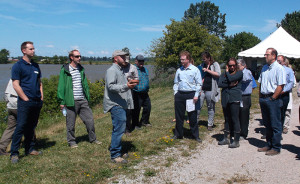
A group comprised of municipalities, conservation authorities, agricultural associations and others has been formed to find ways to reduce phosphorus in local waterways.
The Thames River Phosphorus Reduction Collaborative plans a multi-level approach to reducing phosphorus, which degrades water quality and causes algae blooms in Lake Erie.
The Ontario Federation of Agriculture and the Great Lakes and St. Lawrence Cities Initiative are creators of the collaborative which formally launched its effort with a tour of Chatham-Kent June 27.
Co-chair of the collaborative, Chatham Mayor Randy Hope, said the group realizes that a “one size fits all” approach isn’t going to work.
“Each watershed, and even portions of the same watershed, have different challenges,” he said in a release.
Mark Reusser, vice-president of the Ontario Federation of Agriculture, said the group has gathered global research and is determining what methods best suit Southwestern Ontario.
The majority of phosphorus enters waterways through rapid ice melting in spring and heavy storms in summer.
An algae bloom in Lake Erie in 2014 forced the closure of Toledo Ohio’s water intake system.
South Kent Coun. Trevor Thompson, who took the tour, said he learned a lot. “We’re not here to point fingers at any particular group but to work together to find solutions that will benefit all of us,” he said in a release.






